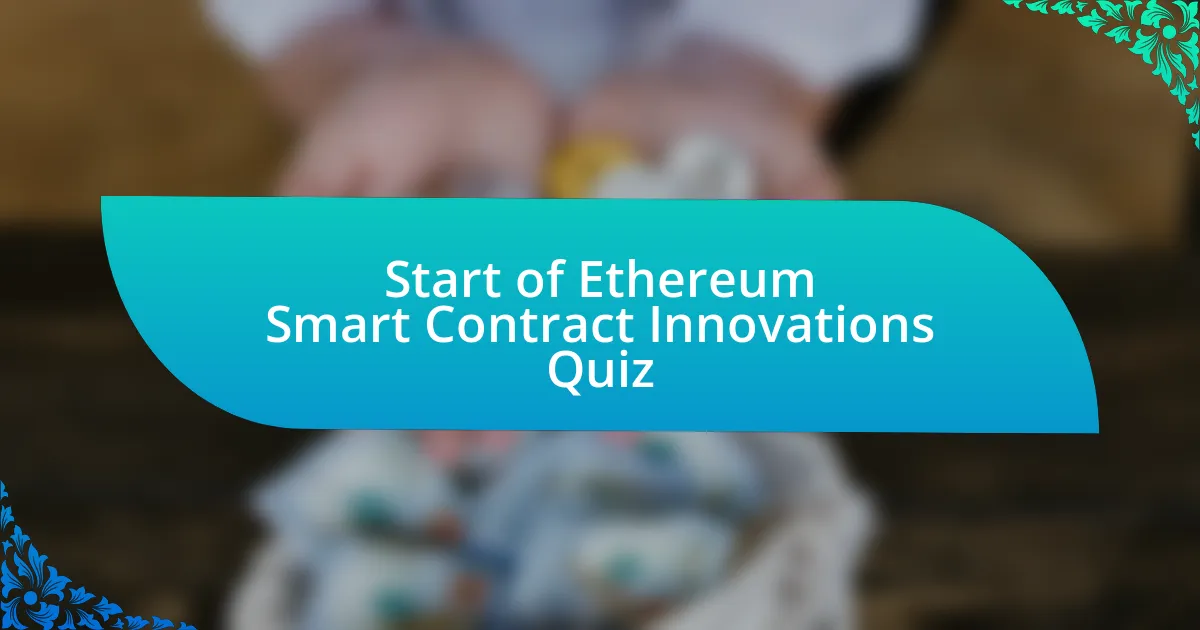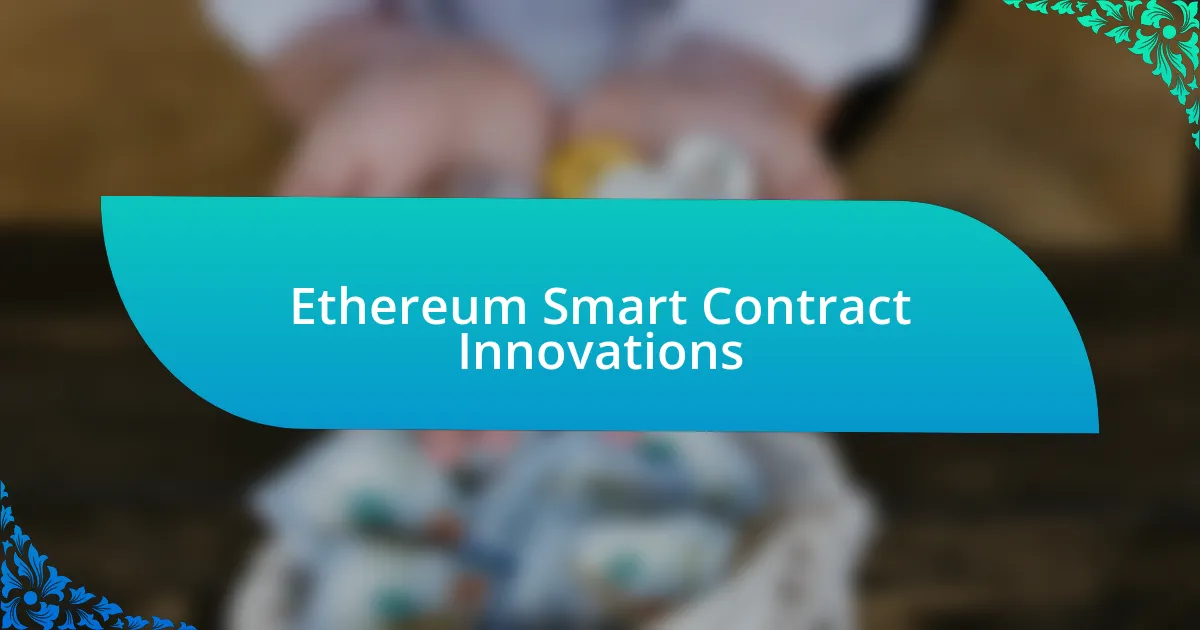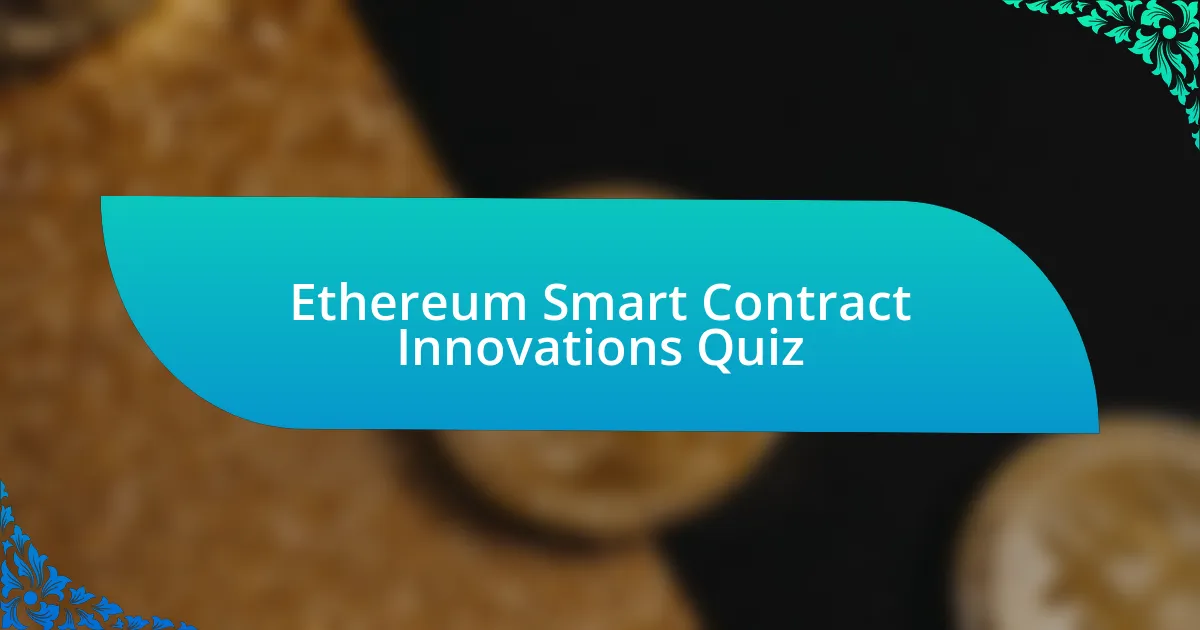
Start of Ethereum Smart Contract Innovations Quiz
1. What is the Ethereum Virtual Machine (EVM) responsible for in the Ethereum ecosystem?
- The EVM generates new Ether through mining.
- The EVM provides a storage solution for Ethereum wallets.
- The EVM processes transactions, verifies their validity, and executes smart contracts.
- The EVM acts as a wallet service for users in the network.
2. Who collaborated with Vitalik Buterin in creating Ethereum?
- ConsenSys
- Gavin Wood
- Charles Hoskinson
- Joe Lubin
3. What digital currency serves as the native token of Ethereum?
- Ether (ETH)
- Ripple (XRP)
- Bitcoin (BTC)
- Litecoin (LTC)
4. How does Ether function within the Ethereum network?
- Ether is a crypto-fuel that powers the Ethereum network.
- Ether is a social media platform built on blockchain.
- Ether is a type of hardware used for mining.
- Ether is an algorithm for predicting market prices.
5. What characteristics define smart contracts on the Ethereum platform?
- Smart contracts rely solely on paper agreements and witnesses for execution.
- Smart contracts are self-executing programs that automate processes and are transparent.
- Smart contracts are stored in a centralized database accessible only to certain users.
- Smart contracts are physical documents that require notarization for validity.
6. What are the two principal account types recognized by Ethereum?
- User Accounts and Machine Accounts
- Offline Accounts and Remote Accounts
- Centralized Accounts and Decentralized Accounts
- Externally Owned Accounts (EOAs) and Contract Accounts
7. How many decimal places can Ether be divided into?
- 16
- 10
- 20
- 18
8. In what way do smart contracts automate complex processes?
- Smart contracts operate only in centralized systems, requiring third-party verification.
- Smart contracts can be manually altered, losing their automation capability.
- Smart contracts automate the completion of processes, reducing the need for intermediaries.
- Smart contracts are solely for cryptocurrency transactions without broader applications.
9. What role does the EVM play in transaction processing on Ethereum?
- The EVM processes transactions submitted to the Ethereum network.
- The EVM compiles programming languages into bytecode.
- The EVM manages network hardware and infrastructure for Ethereum nodes.
- The EVM serves as a decentralized storage system for blockchain data.
10. How does account abstraction influence Ethereum wallet functionality?
- Account abstraction forces all transactions to be approved by the Ethereum Foundation before execution.
- Account abstraction simplifies transaction fees, making them zero for all users on Ethereum.
- Account abstraction enhances wallet functionality by enabling smart contracts, allowing for features like social recovery and advanced customization.
- Account abstraction limits wallets to only store Ether and no other tokens or assets.
11. Can you explain the concept of ERC-4337 and its significance?
- ERC-4337 reduces the transaction fees on all Ethereum transactions.
- ERC-4337 limits the functions of externally owned accounts in Ethereum.
- ERC-4337 allows smart contract wallets to manage transactions without needing protocol-level changes.
- ERC-4337 introduces a new cryptocurrency for the Ethereum network.
12. What type of security features do smart contract wallets provide?
- Mandatory two-factor authentication and SMS verification.
- Single private key for all transactions.
- Physical security tokens and hardware wallets.
- Flexible ownership, asset management, and automation.
13. How do smart contract wallets enhance user privacy?
- Complete anonymity through untraceable transactions and hidden addresses.
- Mandatory public disclosure of all transaction details for verification.
- Use of centralized databases to store transaction information securely.
- Privacy-preserving transactions, social recovery of wallets, on-chain identities, and more.
14. What mechanism allows EOAs to sign transactions on Ethereum?
- Smart contract addresses
- Private keys
- Public keys
- Multi-signature wallets
15. What distinguishes smart contract wallets from externally owned accounts in transaction management?
- Smart contract wallets manage transactions by utilizing code rules and automation.
- Externally owned accounts require manual approval for each transaction.
- Externally owned accounts can execute complex contracts directly within transactions.
- Smart contract wallets only function with fixed protocols and cannot adapt.
16. How do Layer 2 solutions contribute to Ethereum`s scalability?
- Layer 2 solutions offload transactions from the main Ethereum chain, enabling faster and more cost-efficient processing.
- Layer 2 solutions create new tokens on the Ethereum chain for faster transactions.
- Layer 2 solutions verify transactions on the main Ethereum chain without any modifications.
- Layer 2 solutions only improve the user interface of Ethereum wallets.
17. Name two prominent Layer 2 technologies used on Ethereum.
- Oracle Networks
- Sidechains
- Optimistic Rollups
- Plasma Chains
18. What advantages do smart contracts bring to financial transactions?
- Smart contracts eliminate the need for digital currencies entirely in transactions.
- Smart contracts complicate financial transactions by introducing additional fees.
- Smart contracts require physical paperwork for verification of transactions.
- Smart contracts automate financial services, making transactions efficient without intermediaries.
19. Describe the principle of immutability as it applies to smart contracts.
- Smart contracts can be easily changed at any time.
- Smart contracts cannot be modified or deleted once deployed.
- Smart contracts must be deleted to update their functionality.
- Smart contracts operate indefinitely without any need for deployment.
20. In what manner does the EVM facilitate trustless smart contract execution?
- The EVM allows users to modify smart contracts during execution.
- The EVM ensures trustless execution by making all interactions with smart contracts irreversible.
- The EVM requires manual confirmation for smart contract execution.
- The EVM makes transactions reversible upon request.
21. What function does Gas serve in the Ethereum ecosystem?
- Gas is a protocol for blockchain communications.
- Gas is a type of cryptocurrency used for trading.
- Gas refers to a specific programming language in Ethereum.
- Gas is an internal pricing mechanism used by the EVM to execute transactions.
22. What is the purpose of the JSON-RPC interface in Ethereum?
- Ethereum nodes interact with the outside world using the JSON-RPC interface.
- JSON-RPC is a tool for mining new Ether.
- JSON-RPC enables offline transactions in Ethereum.
- JSON-RPC provides a means to store Ethereum data efficiently.
23. Which programming languages are commonly used to develop Ethereum smart contracts?
- Java
- Solidity
- C#
- Python
24. What is Truffle`s role in Ethereum development?
- Truffle is a popular testing and development environment for Ethereum.
- Truffle is a cryptocurrency wallet for storing Ether.
- Truffle is a privacy feature in Ethereum transactions.
- Truffle is a consensus algorithm used in the Ethereum blockchain.
25. How does Testnet benefit Ethereum developers during the testing phase?
- Testnet increases transaction fees on the main Ethereum network.
- Testnet is only used for creating new tokens on Ethereum.
- Testnet eliminates the need for coding when developing applications.
- Testnet allows developers to test dApps and smart contracts without using real Ether.
26. Can transactions on the Ethereum blockchain be concealed?
- Only private accounts can hide transactions.
- Yes, transactions are completely hidden.
- No, all transactions are public.
- Transactions can be concealed with special tools.
27. What occurs if a smart contract transaction exhausts its Gas allocation?
- All state changes are reverted, and the used Gas is lost.
- The transaction succeeds, but the Gas is returned.
- The transaction is completed with no changes.
- The Gas allocation is automatically increased.
28. How does Ethereum`s method of verifying account state differ from Bitcoin`s approach?
- Ethereum checks transaction history for balances, while Bitcoin checks account IDs.
- Ethereum verifies transactions based solely on block height, while Bitcoin verifies based on smart contracts.
- Ethereum uses an account-based model to verify balances and states, while Bitcoin uses a UTXO model.
- Ethereum relies on a centralized server for verifying account states, while Bitcoin does not.
29. What is the function of Remix in the smart contract development process?
- Remix is a type of cryptocurrency used for trading on exchanges.
- Remix is a decentralized storage solution for Ethereum.
- Remix is a consensus algorithm for validating transactions on Ethereum.
- Remix is a useful online tool that can be used to deploy, test, and develop smart contracts.
30. Identify a key trend impacting the future of digital assets on Ethereum.
- Centralized exchanges
- Local currencies
- Decentralized finance (DeFi)
- Traditional banking

Quiz Successfully Completed!
Congratulations on finishing the quiz on Ethereum Smart Contract Innovations! This journey has hopefully deepened your understanding of how smart contracts function and their transformative potential. You may have learned about key concepts, recent advancements, and the practical applications of smart contracts in various industries.
This quiz not only tested your knowledge but also encouraged you to think critically about the impacts of these innovations. Perhaps you now have a better grasp of how Ethereum’s blockchain technology is shaping the future of decentralized applications and finance. Such insights are crucial as they enable you to engage more meaningfully in discussions about technology and its implications.
We invite you to continue exploring this fascinating topic. Our next section on Ethereum Smart Contract Innovations offers an in-depth look at emerging trends and case studies. By diving in, you can further expand your knowledge and stay updated on the latest developments in the field. Happy learning!

Ethereum Smart Contract Innovations
Introduction to Ethereum Smart Contracts
Ethereum smart contracts are self-executing contracts with the terms of the agreement directly written into code. They run on the Ethereum blockchain, which ensures security and immutability. Smart contracts automate transactions and processes without intermediaries. This innovation enhances transparency and reduces costs in various applications, from finance to supply chain management. Their decentralized nature prevents fraud and ensures trust among parties involved.
Decentralized Finance (DeFi) Innovations
Ethereum smart contracts enable DeFi applications, revolutionizing traditional finance. DeFi platforms use smart contracts to facilitate lending, borrowing, and trading without banks. They rely on automated protocols for governance and risk management. This innovation expands access to financial services globally. Users can interact directly with applications, eliminating the need for intermediaries. The growing ecosystem enhances liquidity and efficiency within financial markets.
Token Standards and ERC Protocols
Ethereum supports various token standards like ERC-20 and ERC-721, defining how tokens operate on the platform. ERC-20 allows for fungible tokens, enabling seamless transfers and trading. In contrast, ERC-721 introduces non-fungible tokens (NFTs), offering unique digital assets verified on the blockchain. These standards foster innovation by simplifying the creation and integration of new tokens. Their adoption has driven the growth of NFT marketplaces and unique digital assets, highlighting Ethereum’s versatility.
Smart Contract Development Frameworks
Numerous frameworks facilitate Ethereum smart contract development, enhancing programmer efficiency and safety. Tools like Truffle, Hardhat, and Remix provide environments for testing, deploying, and managing smart contracts. They incorporate features such as debugging and automated testing, ensuring code reliability. These frameworks enable developers to focus on functionality rather than underlying infrastructure. Consequently, they accelerate the deployment of innovative solutions within the Ethereum ecosystem.
Layer 2 Scaling Solutions
Layer 2 scaling solutions address Ethereum’s scalability issues while preserving smart contract functionality. Technologies like Optimistic Rollups and zk-Rollups enhance transaction speed and reduce costs without compromising security. These solutions enable mass adoption by allowing more transactions per second, a critical factor for high-demand applications. Such innovations demonstrate Ethereum’s adaptability and commitment to overcoming existing limitations, making it more efficient for users and developers alike.
What are Ethereum smart contracts?
Ethereum smart contracts are self-executing contracts with the terms directly written into code. They run on the Ethereum blockchain, facilitating, verifying, and enforcing the performance of the contract automatically. Smart contracts eliminate the need for intermediaries and create trust through decentralization. According to the Ethereum Foundation, the ability to execute predetermined agreements programmatically enhances efficiency and reduces costs.
How do Ethereum smart contracts work?
Ethereum smart contracts work by executing predefined rules and conditions encoded in the Ethereum blockchain. When specific conditions are met, the contract automatically triggers actions, such as transferring assets. The Ethereum Virtual Machine (EVM) runs these contracts, ensuring that the transactions are immutable and verifiable. In 2020, it was reported that Ethereum facilitated over 1.5 million smart contracts, showcasing its effectiveness in various sectors.
Where are Ethereum smart contracts used?
Ethereum smart contracts are used across various industries, including finance, supply chain, and gaming. DeFi (Decentralized Finance) platforms utilize smart contracts for lending, borrowing, and trading without intermediaries. According to DeFi Pulse, as of September 2021, the total value locked in DeFi contracts exceeded $80 billion, highlighting their widespread adoption.
When were Ethereum smart contracts introduced?
Ethereum smart contracts were introduced with the launch of the Ethereum platform in July 2015. The concept was proposed by Vitalik Buterin in late 2013, aiming to extend blockchain technology’s capabilities beyond simple transactions. Following its release, Ethereum quickly became the leading platform for developing smart contracts.
Who developed Ethereum smart contracts?
Ethereum smart contracts were developed by Vitalik Buterin and his team at Ethereum, which he co-founded in 2014. Buterin’s vision was to create a programmable blockchain that enables decentralized applications through smart contracts. The Ethereum White Paper, published in 2013, laid the foundational framework for this innovative technology.

